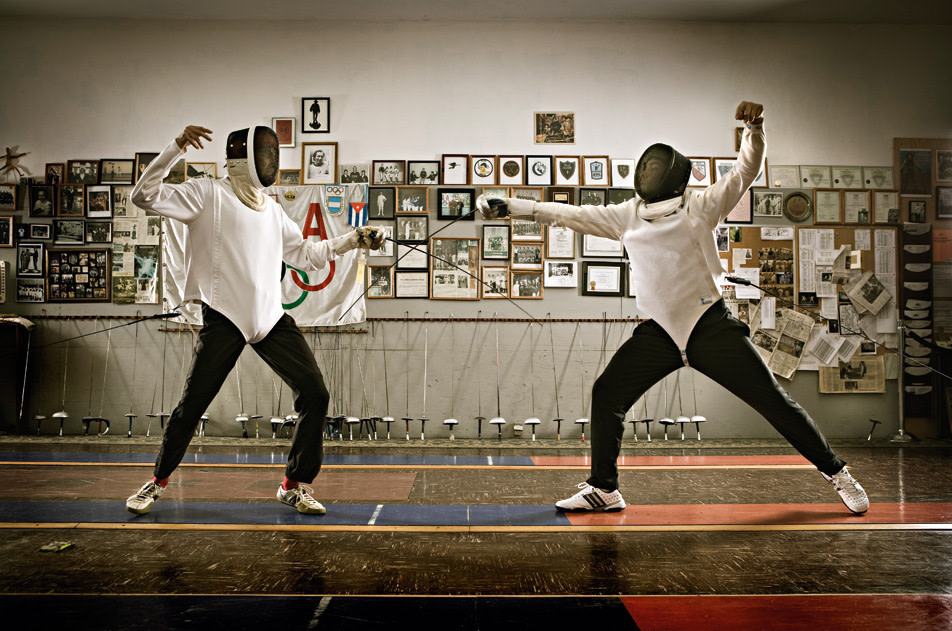Call to Arms

Image: Pete Stone
BACK IN THE MID-1980s, I was all about Robert E. Howard’s fictional badass Conan. As I tore into each carnage-and-cleavage-adorned Conan paperback, I imagined myself stabbing and hacking alongside my hero, whether he was a Destroyer, an Adventurer, or a Usurper (whatever that was). I memorized every leaden line of Teutonic dialogue from Schwarzenegger’s Conan the Barbarian. And when I was 12 and my mom decided to throw a Halloween party, I dressed up, naturally, as the Cimmerian swordsman, a roll of nipple-chafing shag carpet thrown over one shoulder, leather sandals on my feet, and a section of metal vacuum-cleaner tubing serving as my broadsword. (All pictures have since been burned.)
In short, I dug swords. Fortunately, before I did any irrevocable damage to my reputation by, say, performing in medieval reenactments at some renaissance fair, I discovered girls and rock ’n’ roll. Blades and steel were all but forgotten—until recently, when I caught sight of a photo of another hero of mine, Iron Maiden lead shrieker Bruce Dickinson, in a storefront window in St. Johns. He was decked out in all-white fencing gear, brandishing a different kind of heavy metal—a foil. A sign identified the otherwise nondescript business on N Lombard Street as Fencing Center Salle Trois Armes (“Three Arms Hall,” so named because the school teaches students to fence with three different types of swords). If Dickinson—without a doubt one of the scariest rockers I know—was man enough to don tights and a face mask, I figured I could, too. I signed up for a lesson.
When I arrive to observe a lesson I find a narrow room lined with all sorts of swashbuckling paraphernalia: Zorro movie posters, suits of armor, and rusty 19th-century combat swords. Inside, 12 people are jumping about, thrusting and waving their épées like giant wands. The studio’s location seems odd, given St. Johns’s working-class reputation and the fact that I consider fencing a pastime for aristocratic prep-schoolers. But when I meet the center’s owner, Rocky Beach (yes, that’s his real name)—a fixture on Portland’s fencing scene for 40 years who helped select an Olympic coach for Beijing Olympic medalists Mariel Zagunis and Becca Ward—he explains that the sport is more tough-nosed than I thought.
“This was basically the sidearm of the 1700s,” Beach says allowing me to fondle the business end of a short sword. “It was made to drop someone—to penetrate vital organs.” Awesome.
Of course, today fencing is a civilized game in which heavily padded uniforms, round-tipped swords, and mesh face-masks minimize danger. It’s played out on a narrow strip of raised wood called a piste, and the type of blade used determines how points are scored. Épées and foils both look like oversize needles, but the blade of a foil is lighter and more flexible than that of an épée. When sparring with an épée, a player can target the entire body.With the foil, however, only shots to the torso are considered valid. In contests involving a saber, which has a wider base that narrows at the tip, anything above the waist (except for the hands) is fair game. All combatants are rigged to extendable cords; these attach to electronic vests that register hits on a small digital scoreboard. The first person to score 15 hits wins the match.
A few nights later, when I return for my first official lesson, Salle Trois Armes is once again alive with the sound of clanking metal and the onion-y scent of perspiration. “Fencing works every muscle in the body,” Beach says. I’m skeptical, since much of his teaching revolves around relaxation. But after working on first position (the starting point of any match, it vaguely resembles the “I’m a Little Teapot” dance), executing a few parrying steps and lunges, and swinging a five-pound sword in the air, my butt, thighs, and deltoids are revved to a burn.
Most pupils don’t see combat until around their 10th lesson, but Beach makes an exception and suits me up. After I’ve donned a heavy unitard that looks a bit like a straitjacket and a helmet that’s as heavy as a pumpkin, Beach hands me a saber. I notice a series of scars running up his forearm. “Not from fencing,” he says, trying to reassure me. “I worked in a factory where we used a lot of different saws.”
“Besides,” he adds, “to my knowledge, nobody has died from fencing in the last hundred years.” With that he flips the mask over his face: “En garde!”
I’m told to hold the sword like a car key, with the tips of my forefinger and thumb stuck up next to the hilt and the rest of the handle tucked against my palm. Beach walks me through a variety of defensive positions that often entail using my opponent’s force and inertia against him. From there we jump to theatrical moves, the kind of running-in-a-circle-and-trading-blows choreography found in films like The Princess Bride or Star Wars. “You see movies with blind samurais doing these amazing sword moves,” Beach says. “We actually do that—I’ve had blind students who could kick your butt.”
That wouldn’t be hard. The foundation of fencing is built upon good footwork. Balance. Grace from the waist down. I have none of these. Instead I feel like a bear trying to dance on top of a ball.
But thanks to Beach’s Job-like patience, I begin to pick up on the rhythm of fencing: the clang of the foils, the squeak of tennis shoes. It’s hypnotizing—until, taking the training wheels off, Beach lunges toward me.
Instinctively my right arm crosses my torso, blocking his saber as it slashes to my left side. Our swords clash loudly and momentarily lock into place. Just like Beach taught me, I quickly flick the digits holding my sword back toward him with a subtle snapping motion. My weapon, which was protecting my rib cage, is now driving into Beach’s chest. Upon contact the blade bows dramatically from the pressure of what most certainly would have been a fatal blow. If not for the sword’s plastic tip, Beach would be a human kebab.
He let me win, of course. Through his mask I can see his mustache curling up at the edges; he’s pleased about the mock-impalement. Still, I’m tingling with excitement. A knot of what can be described only as pure primal bloodlust coils in the small of my back. I hold back a barbarian’s yell. Conan would be proud.




